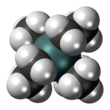| Revision as of 22:57, 4 December 2024 editBernanke's Crossbow (talk | contribs)Extended confirmed users7,844 edits →top: Clarify← Previous edit | Latest revision as of 22:58, 4 December 2024 edit undoBernanke's Crossbow (talk | contribs)Extended confirmed users7,844 edits →top: links etc | ||
| Line 58: | Line 58: | ||
| The same reaction can be used to obtain ] and ].<ref name=kerk/> | The same reaction can be used to obtain ] and ].<ref name=kerk/> | ||
| Tetraethyltin is converted in the body to the more toxic ] ions.<ref name=cremer>Jill E. Cremer (1958), "The biochemistry of organotin compounds. The conversion of tetraethyltin into triethyltin in mammals". ''Biochem J.'' volume 68, issue 4, pages 685–692. Cremer refers to the ions as the ambiguous "triethyltin", but cites H. B. Stoner, J. M. Barnes, and J. I. Duff (1955) |
Tetraethyltin is converted in the body to the more toxic ] ions.<ref name=cremer>Jill E. Cremer (1958), "The biochemistry of organotin compounds. The conversion of tetraethyltin into triethyltin in mammals". ''Biochem J.'' volume 68, issue 4, pages 685–692. Cremer refers to the ions as the ambiguous "triethyltin", but cites H. B. Stoner, J. M. Barnes, and J. I. Duff (1955), ''Brit. J. Pharmacol.'' volume 10, issue 16, which indicates that the compounds in question are ] and ].</ref> | ||
| ==See also== | ==See also== | ||
Latest revision as of 22:58, 4 December 2024
| |||
| Names | |||
|---|---|---|---|
| IUPAC name Tetraethyltin | |||
| Other names
Tetraethyl tin Tetraethylstannane | |||
| Identifiers | |||
| CAS Number | |||
| 3D model (JSmol) | |||
| Abbreviations | TET | ||
| ChemSpider | |||
| ECHA InfoCard | 100.009.007 | ||
| EC Number |
| ||
| MeSH | Tetraethyltin | ||
| PubChem CID | |||
| UNII | |||
| UN number | 3384 2788 | ||
| CompTox Dashboard (EPA) | |||
InChI
| |||
SMILES
| |||
| Properties | |||
| Chemical formula | (CH3CH2)4Sn | ||
| Molar mass | 234.958 g·mol | ||
| Appearance | Colourless liquid | ||
| Density | 1.187 g cm | ||
| Melting point | −112 °C (−170 °F; 161 K) | ||
| Boiling point | 181 °C (358 °F; 454 K) | ||
| Hazards | |||
| GHS labelling: | |||
| Pictograms |   
| ||
| Signal word | Danger | ||
| Hazard statements | H226, H300, H310, H330, H410 | ||
| Precautionary statements | P210, P233, P240, P241, P242, P243, P260, P262, P264, P270, P271, P273, P280, P284, P301+P310, P302+P350, P303+P361+P353, P304+P340, P310, P320, P321, P322, P330, P361, P363, P370+P378, P391, P403+P233, P403+P235, P405, P501 | ||
| NFPA 704 (fire diamond) |
 | ||
| Flash point | 53 °C (127 °F; 326 K) | ||
| Related compounds | |||
| Related Tetraalkylstannanes | |||
| Related compounds | |||
| Except where otherwise noted, data are given for materials in their standard state (at 25 °C , 100 kPa).
| |||
Tetraethyltin or tetraethyl tin is a chemical compound with the formula (CH3CH2)4Sn, that is, a tin atom attached to four ethyl groups. It is an important example of an organotin compound, often abbreviated as TET.
Tetraethyltin is a colourless flammable liquid, soluble in diethyl ether and insoluble in water, that freezes at −112 °C and boils at 181 °C. It is used in the electronics industry.
Tetraethyltin can be obtained by reacting ethylmagnesium bromide with tin(IV) chloride:
- SnCl4 + 4 CH3CH2MgBr → (CH3CH2)4Sn + 4 MgBrCl
The same reaction can be used to obtain tetra-n-propyltin and tetra-n-butyltin.
Tetraethyltin is converted in the body to the more toxic triethylstannylium ions.
See also
References
- ^ G. J. M. Van Der Kerk and J. G. A. Luijten (1956), "Tetraethyltin". Organic Syntheses, volume 36, page 86; Coll. Vol. 4, p.881 (1963)
- SAFC corp, tetraethyltin catalog page. Accessed on 2011-01-18.
- Jill E. Cremer (1958), "The biochemistry of organotin compounds. The conversion of tetraethyltin into triethyltin in mammals". Biochem J. volume 68, issue 4, pages 685–692. Cremer refers to the ions as the ambiguous "triethyltin", but cites H. B. Stoner, J. M. Barnes, and J. I. Duff (1955), Brit. J. Pharmacol. volume 10, issue 16, which indicates that the compounds in question are triethyltin hydroxide and sulfate.
This article about an organic compound is a stub. You can help Misplaced Pages by expanding it. |

